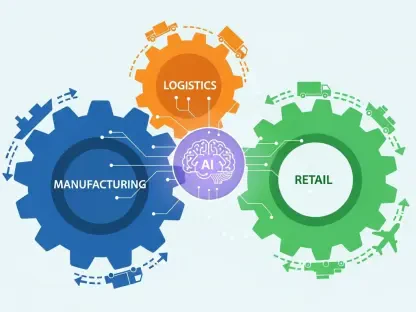The digital age is characterized by an ever-increasing reliance on data to drive decision-making processes across various industries. Companies are constantly seeking ways to enhance their efficiency, responsiveness, and adaptability in this fast-paced environment. Edge computing is emerging as a pivotal technology that promises to revolutionize real-time analytics by addressing latency issues, ensuring faster data processing, and empowering organizations to make instantaneous decisions. The focus of this exploration is to understand how edge computing is redefining real-time analytics and providing groundbreaking advantages to industries such as healthcare, finance, manufacturing, and autonomous systems.
The Rise of Edge Computing in Real-Time Analytics
Understanding Edge Computing and Its Impact
Edge computing represents a paradigm shift, bringing data processing closer to the source of data generation. Unlike traditional architectures that rely heavily on centralized cloud data centers, edge computing focuses on local processing at the network’s periphery, substantially reducing the time required for data transmission. This approach mitigates latency, the delay between data input and response, which is crucial for time-sensitive applications. Industries such as healthcare, where immediate decision-making can be a matter of life or death, are adopting edge computing to ensure real-time responsiveness and heightened efficiency.
The mechanism of edge computing is especially beneficial with the proliferation of Internet of Things (IoT) devices, which generate vast amounts of data requiring low-latency processing. By enabling analytics to occur closer to the data source, edge computing minimizes dependency on constant internet connectivity. This is a significant advantage, as it allows businesses to maintain operations even in low-connectivity environments or during network disruptions. Furthermore, this paradigm supports the burgeoning demand for data sovereignty, enabling companies to adhere to stringent data privacy regulations by keeping data processing within local jurisdictions.
Enhancing AI Capabilities with Edge Integration
Incorporating artificial intelligence (AI) into edge computing systems signifies a transformative step forward in real-time analytics. AI’s computationally intensive nature often poses challenges for traditional systems, which are alleviated by edge computing’s capabilities. By optimizing AI algorithms for edge devices, latency linked to data transfers from devices to cloud-based systems is effectively eradicated. Consequently, AI functionality can be localized, allowing for faster and more efficient data processing, which is critical in applications that necessitate rapid decision-making.
Industries leveraging edge AI technology witness significant improvements in their operations. For instance, with autonomous systems, edge AI facilitates immediate decision-making by processing data locally rather than relying on distant cloud servers. Similarly, in industrial settings, edge-facilitated AI empowers predictive maintenance practices by enabling machines to analyze data in real-time and anticipate failures before they result in costly downtimes. Overall, edge computing seamlessly integrates with AI, helping industries achieve faster, smarter, and safer operational outcomes.
Diverse Applications of Edge AI in Various Industries
Transformations in Autonomous Vehicles
Autonomous vehicles epitomize the need for low-latency AI processing, where immediate response times are critical for safety and efficiency. Edge AI empowers self-driving cars to handle sensory data on the fly, enabling them to detect obstacles, make navigation decisions, and respond to dynamic road conditions independently of external networks. This ensures the vehicle maintains operational integrity and makes expedient decisions based on the current environment. Furthermore, edge AI reduces the need for data to be relayed to and from cloud servers, significantly decreasing latency and enhancing reliability through localized processing.
The integration of edge AI in autonomous vehicles not only augments safety but also optimizes route management and vehicle performance. Vehicles can adapt to changing traffic patterns, implement route recalibrations, and proactively identify maintenance needs, thereby ensuring smoother operation. Moreover, manufacturers save on bandwidth costs by limiting data transmissions to the cloud, streamlining operational efficiency by keeping computational tasks within the vehicle’s local systems. The continuous development of edge AI solutions plays a vital role in advancing the capabilities of autonomous transportation technologies.
Medical Advancements through Edge AI
Healthcare stands to benefit immensely from edge AI applications, particularly in the realm of medical imaging and diagnostics. By equipping medical devices with edge computing capabilities, facilities can process and analyze patient data in real-time, thus accelerating diagnostics and treatment planning. Devices such as AI-powered imaging tools can autonomously interpret radiological images and provide immediate insights to healthcare professionals. This rapid processing bypasses the bottleneck created by traditional cloud computing, which can suffer from high latency and network reliability issues.
In addition to improving diagnostic speed, edge AI holds promise for improving patient privacy and data security. By processing sensitive healthcare information locally, organizations reduce the risk of data breaches during cloud transfers. This localized approach aligns with stringent data protection regulations, providing healthcare facilities with the ability to optimize their workflows while safeguarding patient confidentiality. The introduction of edge AI into healthcare systems is revolutionizing how medical data is managed, paving the way for more efficient and secure healthcare delivery.
Overcoming Challenges and Embracing Efficiency
Addressing Hardware and Performance Constraints
While edge computing offers a multitude of benefits, its implementation is not without challenges. Edge devices are often constrained by their compact size, which can limit computational resources. Running resource-intensive AI models on these devices demands innovative approaches to optimization. Developers are now focusing on creating algorithms specifically designed to operate under these constraints. These optimized models, along with techniques like model compression, enhance the performance capability of edge devices without compromising their efficiency.
Additionally, the power consumption of edge devices poses a significant challenge, especially when they are battery-operated. However, strides are being made in the development of low-power chips tailored for edge applications. These energy-efficient components ensure that edge devices remain operational for extended periods without frequent recharging. By prioritizing developments in both hardware and software, manufacturers continue to address the limitations of edge computing, facilitating its broader adoption across various industries.
Ensuring Security and Best Practices
As edge computing grows in prominence, ensuring the security of these distributed networks is paramount. The decentralized nature of edge systems, while advantageous for data processing efficiency, can make them susceptible to cyber threats. Strong encryption and secure communication protocols are essential to protect data as it moves across the network. Furthermore, advancements in secure hardware solutions are being explored to provide an added layer of protection to edge devices.
Maintaining and updating AI models at the edge also requires innovative solutions. Techniques such as federated learning allow models to be updated from decentralized data sources while preserving data privacy. This approach ensures that edge AI systems remain current and effective without extensive data transmission back to the central server. With a continual focus on enhancing the security infrastructure and model management strategies, edge computing is poised to offer sustainable and secure real-time analytics solutions.
Conclusion: The Future of Edge in Analytics
In today’s digital era, the reliance on massive amounts of data is pivotal to decision-making in numerous industries. Organizations continually search for methods to boost their efficiency, improve responsiveness, and enhance adaptability in this rapidly evolving landscape. A technology that is making significant strides in this area is edge computing. This innovation holds the potential to transform real-time analytics by tackling latency problems, facilitating faster data processing, and enabling companies to make split-second decisions. By bringing data processing closer to the data source, edge computing minimizes the time taken to process and analyze data, providing an unparalleled speed advantage. Industries such as healthcare, finance, manufacturing, and autonomous systems stand to gain immensely by integrating edge computing, leveraging its capacity for immediate data analytics to enhance their operations. As these sectors seek to harness the power of real-time insights, edge computing emerges as a key enabler, offering transformative benefits and fostering unparalleled growth and innovation.









